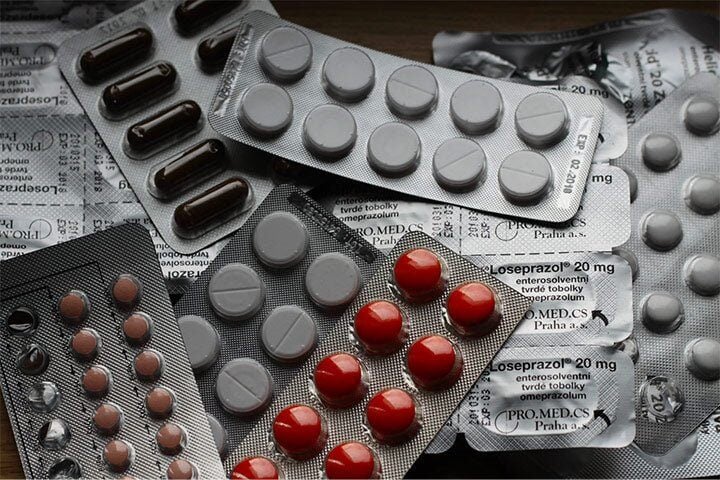Drug-induced Urinary Incontinence

Urinary incontinence (UI) is the involuntary leakage of urine, and while it’s often associated with aging, it is not a normal or inevitable part of growing older. In men, it can result from prostate problems, nerve damage, or bladder muscle dysfunction—but what many don’t realize is that certain medications can also cause or worsen UI.
Introduction
Drugs used for high blood pressure, depression, sleep disorders, and even colds can interfere with the normal function of the bladder or the nerves that control urination. This is especially important for men who take multiple medications daily. Identifying drug-induced UI is crucial because it may be reversible simply by adjusting or stopping the culprit medication.
Epidemiology and Prevalence in Men
Urinary incontinence (UI) affects approximately 17% of men overall, with prevalence increasing with age. In men aged 60 to 64 years, the prevalence is about 11%, rising to 31% in those aged 85 and older.
Despite its commonality, drug-induced UI is often underreported due to the embarrassment associated with the condition. Additionally, it is frequently misdiagnosed as benign prostatic hyperplasia (BPH) or simply attributed to aging, which can delay appropriate treatment. This underreporting highlights the importance of recognizing drug-related causes of UI, especially as more men are prescribed medications that impact bladder function.
Causes of Drug-Induced Urinary Incontinence
Medications can interfere with the complex coordination between the brain, bladder, and muscles involved in urinary control. Normally, the bladder fills and stores urine with help from sympathetic nerves, which relax the bladder muscle (detrusor) and tighten the bladder outlet (sphincter). When it's time to urinate, parasympathetic nerves signal the bladder to contract and the sphincter to relax. Drugs that interfere with any of these pathways can tip the balance and cause urine leakage.
Some drugs lower bladder outlet resistance, making it harder to hold in urine. Others increase bladder pressure or impair the brain’s control over urination. This disruption in the pressure relationship between the bladder and the urethra is one of the key ways drug-induced UI occurs
Medications that affect the central nervous system (CNS), such as sedatives, benzodiazepines, and antipsychotics, can impair the brain’s ability to control bladder function. These drugs may delay the awareness of the urge to urinate or cause detrusor overactivity, leading to urge incontinence. They can also disrupt dopamine pathways, which play a key role in urinary control, potentially increasing incontinence risk.
On the other hand, medications like alpha-blockers (e.g., tamsulosin), used to treat prostate enlargement, relax the bladder neck and urethra, lowering bladder outlet resistance and making it easier for urine to leak. This effect can contribute to overflow or stress incontinence in men, especially those with weakened pelvic floor muscles or overactive bladders.
Risk Factors & Who Is Most at Risk
Urinary incontinence (UI) in men is multifactorial, with risk increasing significantly with age. Age-related changes in bladder compliance, detrusor overactivity, and reduced urethral closure pressure contribute to decreased urinary control. Polypharmacy, especially in older adults, compounds the issue, as many medications interfere with bladder function or awareness of the urge to void.
Prostate-related conditions, such as benign prostatic hyperplasia (BPH) and post-prostatectomy status, are major contributors to overflow or urge incontinence due to obstruction or sphincter damage. Neurological disorders, including Parkinson’s disease and stroke, impair bladder control pathways, leading to urgency and leakage.
Two studies highlight the strong association between LUTS, poor sleep, depression, and reduced quality of life, emphasizing the burden of urinary symptoms in aging males.
Common Medications That Cause Urinary Incontinence (UI)
Alpha-blockers (e.g., tamsulosin, doxazosin)
Alpha-blockers relax smooth muscle in the bladder neck and prostate, which can lower resistance during urination. However, this also reduces bladder outlet resistance, making it harder to hold urine, especially during physical stress like coughing or lifting—leading to stress incontinence.
Diuretics (e.g., furosemide, hydrochlorothiazide)
Diuretics stimulate the kidneys to produce more urine. This increases bladder filling, urinary urgency, and frequency, often overwhelming bladder control—especially in people with limited mobility or existing bladder issues. This may lead to urge incontinence.
Antidepressants
Some antidepressants like tricyclic antidepressants (TCAs) can relax the bladder or cause urinary retention. Retention increases bladder pressure over time, potentially resulting in overflow incontinence. Others like SSRIs may interfere with awareness of the need to avoid.
Antipsychotics and Sedatives
Antipsychotics (e.g., haloperidol, chlorpromazine) and sedatives can interfere with bladder signaling and muscle tone. They may relax the external urethral sphincter or impair awareness of bladder fullness—leading to functional or urge incontinence. Sedatives, especially benzodiazepines, further contribute through sedation-induced immobility.
Cholinesterase Inhibitors (e.g., donepezil)
Used for Alzheimer’s disease, these drugs increase acetylcholine activity, which stimulates bladder contractions. This can lead to urge incontinence, especially in elderly patients who already struggle with bladder control.
Management and Prevention
Managing drug-induced urinary incontinence (UI) involves a multifaceted approach, targeting both medication-related causes and supportive lifestyle interventions. Here are the core strategies:
Medication Review
Regular medication reviews by a healthcare provider (doctor or pharmacist) are essential—especially in elderly patients or those experiencing new-onset UI. The goal is to identify medications that may contribute to bladder dysfunction, uncover drug interactions, and reduce polypharmacy where possible.
Dose Adjustment or Alternatives
When possible, switch to drugs with fewer urologic side effects. For example, using centrally acting antihypertensives rather than alpha-blockers, or using antidepressants with minimal anticholinergic effects. Timing matters too—diuretics should be taken in the morning to reduce nocturia and urgency later in the day.
Behavioral Strategies
Behavioral interventions can significantly reduce symptoms. Bladder training and scheduled voiding increase bladder capacity and reduce urgency episodes. Avoiding bladder irritants like caffeine and alcohol can also help stabilize symptoms.
Pelvic Floor Therapy
Kegel exercises strengthen the pelvic floor muscles and improve urethral closure pressure. These exercises are beneficial for men with stress or mixed incontinence.
When to See a Doctor
Consult a healthcare provider if urinary incontinence (UI) begins after starting a new medication, worsens despite behavioral changes or therapy, or if you’re on multiple prescriptions. These could be signs of drug-induced UI, and early intervention may prevent complications and improve your quality of life.
Conclusion & Takeaway
Drugs used to treat common conditions like hypertension, depression, or insomnia may quietly disrupt bladder control. The good news? Drug-induced UI is often reversible. By discussing symptoms openly with your doctor or pharmacist, you can adjust your treatment plan and restore bladder function. Early identification and action can significantly improve your comfort and confidence.
For those seeking support, we invite you to purchase a 10 Count Trial Pack here or request a professional-use sample pack for healthcare institutions here.
References:
-
Hashimoto, M., Imamura, T., Tanimukai, S., Kazui, H., & Mori, E. (2000, August 12). Urinary incontinence: An unrecognised adverse effect with donepezil. The Lancet, 356(9229), 568. https://doi.org/10.1016/S0140-6736(00)02588-5
-
Huang, Y. C., & Chang, K. V. (2023, May 1). Kegel exercises. In StatPearls [Internet]. StatPearls Publishing. https://www.ncbi.nlm.nih.gov/books/NBK555912/
-
Irwin, D. E., Kopp, Z. S., Agatep, B., Milsom, I., & Abrams, P. (2011). Worldwide prevalence estimates of lower urinary tract symptoms, overactive bladder, urinary incontinence and bladder outlet obstruction. BJU International, 108(7), 1132–1138. https://doi.org/10.1111/j.1464-410X.2010.09993.x
-
Jung, H. B., Kim, H. J., & Cho, S. T. (2015). A current perspective on geriatric lower urinary tract dysfunction. Korean Journal of Urology, 56(4), 266–275. https://doi.org/10.4111/kju.2015.56.4.266
-
Kim, S. E., Shin, M. S., Kim, C. J., Park, J. H., Chung, K. J., Jung, H., Kim, K. H., Lee, J. H., & Ko, I. G. (2012). Effects of tamsulosin on urinary bladder function and neuronal activity in the voiding centers of rats with cyclophosphamide-induced overactive bladder. International Neurourology Journal, 16(1), 13–22. https://doi.org/10.5213/inj.2012.16.1.13
-
Kiruluta, H. G., & Andrews, K. (1983). Urinary incontinence secondary to drugs. Urology, 22(1), 88–90. https://doi.org/10.1016/0090-4295(83)90360-6
-
Ouslander, J. G., Kane, R. L., & Abrass, I. B. (1982). Urinary incontinence in elderly nursing home patients. JAMA, 248(10), 1194–1198. https://doi.org/10.1001/jama.1982.03330100048022
-
Peron, E. P., Zheng, Y., Perera, S., Newman, A. B., Resnick, N. M., Shorr, R. I., Bauer, D. C., Simonsick, E. M., Gray, S. L., Hanlon, J. T., & Ruby, C. M. (2012). Antihypertensive drug class use and differential risk of urinary incontinence in community-dwelling older women. Journal of Gerontology: Series A, 67(12), 1373–1378. https://doi.org/10.1093/gerona/gls177
-
Resnick, N. M., & Yalla, S. V. (1987). Detrusor hyperactivity with impaired contractile function: An unrecognized but common cause of incontinence in elderly patients. JAMA, 257(22), 3076–3081. https://doi.org/10.1001/jama.1987.03390220058031
-
Stewart, W. F., Van Rooyen, J. B., Cundiff, G. W., Abrams, P., Herzog, A. R., Corey, R., Hunt, T. L., & Wein, A. J. (2003). Prevalence and burden of overactive bladder in the United States. World Journal of Urology, 20(6), 327–336. https://doi.org/10.1007/s00345-002-0301-4
-
Thom, D. H., van den Eeden, S. K., Ragins, A. I., Wassel-Fyr, C., Vittinghof, E., Subak, L. L., & Brown, J. S. (2006). Differences in prevalence of urinary incontinence by race/ethnicity. Journal of Urology, 175(1), 259–264. https://doi.org/10.1016/S0022-5347(05)00039-X
-
Tsakiris, P., Oelke, M., & Michel, M. C. (2008). Drug-induced urinary incontinence. Drugs & Aging, 25(7), 541–549. https://doi.org/10.2165/00002512-200825070-00001
-
Yoshimura, N., & Chancellor, M. B. (2004). Differential diagnosis and treatment of impaired bladder emptying. Reviews in Urology, 6(Suppl 1), S24–S31. https://www.ncbi.nlm.nih.gov/pmc/articles/PMC1472851/

